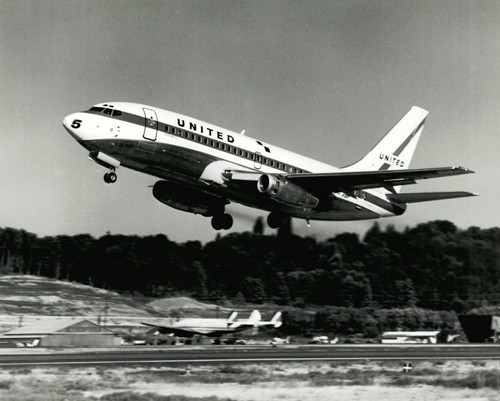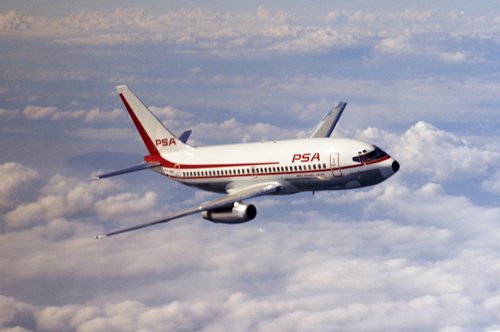Best of Flashback Fridays: Origins of the Boeing 737—Part One
Best of Flashback Fridays: Origins of the Boeing 737—Part One
- Subscribe to RSS Feed
- Mark as New
- Mark as Read
- Bookmark
- Subscribe
- Printer Friendly Page
- Report Inappropriate Content
Brian subtitled this post “The “Originals: The 737-100 and 737-200” as the first installment of a four-part series that originally began on February 17, 2012. Brian gives us an interesting view (as always) of the beginnings of the legacy that is the 737.
Let me know in the comments section if you would like to see Brian’s remaining chapters appear if the “Best of” Flashback Fridays over the next several weeks, and I will be happy to make that happen. In the meantime, happy reading!
The “Originals”: The 737-100 and 737-200
As we prepare to put our first Boeing 737-800 into service and on the heels of our announcement as the launch customer for the 737MAX, I thought it might be fun to take a step back and look at the heritage of this magnificent airliner. Michael Lombardi, Boeing’s Corporate Historian, selected these images for us, and I will share them with you in a four-part series over the next month or so.

You are looking at the very beginning of a family of aircraft that would generate more than 7,000 airframes (and still growing). This is the very first 737, and it is a -100 model. The first six 737s were constructed at Plant 2 at Boeing Field in Seattle. This historic structure was the birthplace of thousands of B-17s during World War II, and the first B-47 and B-52 were built here. The building was razed in 2010, and the site is being returned to wetland status. Unlike the construction photos of our -800s wearing their gray protective coating, the original -100 was in bare metal. This airplane rolled out of the factory on January 17, 1967, and with its first flight on April 9 of that year, the 737 heritage began. After being in the spotlight, this pioneering airframe went on to serve more than 30 years with NASA, and it is now part of the collection of the Museum of Flight at its birthplace, Boeing Field.

Lufthansa was the launch customer for the 737, and only 30 -100s were built, with the German carrier operating the majority. The larger -200 was the aircraft of choice for most airlines, and even Lufthansa opted for the larger, more capable airplane. D-ABCE, above, is one of their 737-230QC aircraft with a large main deck cargo door.

Over 1,100 737-200s would enter service, and United was the launch customer for this successful version. N9001U was the first 737-200 off the production line, and it operated its maiden flight on August 8, 1967, just four months after the 737-100 first took to the air. Of interest in this photo are the calibration markings (the squares above the emergency window exit and the number on the nose) for the test flights. Also, take a look at the “blow-in” doors at the front of the engines. These doors opened to increase the airflow to the early versions of the JT-8D engines that powered the first -200s. (The doors will disappear with the Advanced 737-200, the subject of our next installment).

The 737 revolutionized the airline industry because smaller carriers (and large carriers with shorter flights) could now operate a jetliner that shared the same cabin and comfort level with the 707s flown by Pan American, TWA, American, etc. One of those smaller carriers was PSA, the California intrastate airline that served as an operational model for Southwest. The longtime California airline operated a mixed fleet of 727s and 737s throughout California, and on a personal note, my very first 737 flight was on PSA from San Diego to Los Angeles on August 5, 1969.

This pre-delivery publicity picture from 1971 of our first 737, N20SW, serial number 20369, is one of my favorites for a lot of reasons that include the original livery with the “AIRLINES” title, the brand-new paint, and the photo location over western Washington. It also represents the start of a 40+-year tradition of 737s wearing Southwest colors. This airplane has a lot in common with the PSA example in the previous photo because N20SW was originally built for PSA. During one of those many down times in our economy, PSA wasn’t in a financial position to accept delivery on the airplane. At the time, Southwest was negotiating for its first aircraft with both Boeing for the 737 and Douglas for the DC-9, and according to Herb Kelleher, Boeing won “through a generous ‘last minute’ offer. Hallelujah!” In our next installment, we will look at later variants, including the advanced model of the 737-200 that made it a worldwide best seller.
You must be a registered user to add a comment. If you've already registered, sign in. Otherwise, register and sign in.